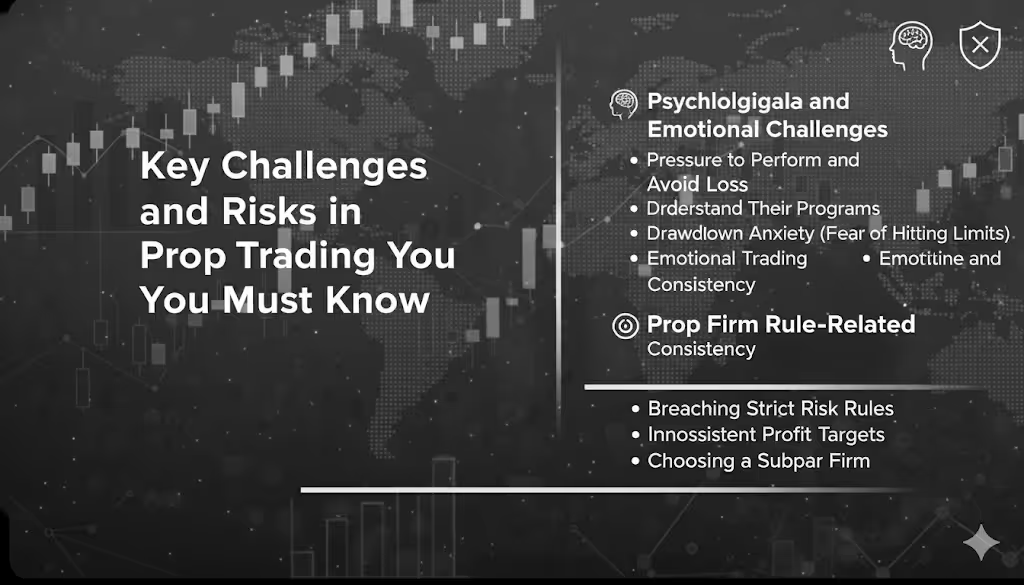Key Challenges and Risks in Prop Trading You Must Know


Prop trading, or proprietary trading, provides traders with access to substantial capital, allowing them to trade using a firm’s funds rather than their own. With firms like Vantir offering opportunities, prop trading presents the potential for high returns. However, it also comes with significant risks that can quickly lead to substantial losses. Understanding these risks is crucial for anyone hoping to navigate this high-stakes environment successfully. In this blog, we will explore the key challenges and risks in prop trading, helping you understand how to manage and overcome them.
Prop trading offers high rewards, but the risks can be equally high. To be successful, traders must navigate these risks effectively. Below, we dive into the primary challenges.
Market risk is the most immediate concern for any trader, as the price movements of assets in the market are unpredictable. Prop traders often deal with fast-moving markets, where assets can change prices within minutes. A major risk is exposure to extreme market volatility, which can result in significant losses.
For instance, a trader might anticipate an asset’s price increase but be blindsided by unforeseen news that causes the market to move against them. Prop trading firms can mitigate this risk by employing sophisticated data analysis and charting tools that help traders track market trends and make informed decisions. Tools like moving averages, Bollinger Bands, and Relative Strength Index (RSI) are essential in managing this risk effectively.
Risk management is a key aspect of prop trading, with firms setting stringent rules to ensure traders do not exceed risk limits. These rules are implemented to protect the capital of the firm and ensure profitability is sustained over time. For instance, how prop trading firms manage risk often involves establishing daily loss limits, position limits, and drawdown caps.
These rules, while necessary for the firm’s security, can create a high-pressure environment for traders. For example, traders may be forced to exit profitable trades prematurely or may face restrictions on taking certain high-risk positions. Traders must adapt by learning how to pass prop trading challenges and secure funding without breaking these risk management guidelines.
The pressure to perform and the fear of losing the firm’s capital can cause emotional stress, which can lead to emotional trading. This happens when traders make impulsive decisions based on fear, greed, or anxiety rather than adhering to a disciplined strategy. Over time, this can lead to poor decision-making and substantial losses.
Traders who succeed in prop trading must build emotional resilience. Developing emotional discipline is critical to staying focused, sticking to a trading plan, and avoiding risky behavior like chasing losses or deviating from the strategy. Understanding how to manage stress effectively is essential for long-term profitability in prop trading.
One of the primary risks in prop trading is over-leveraging, which occurs when traders use more borrowed capital than they can afford to lose. Leverage amplifies both potential profits and losses, meaning a trader’s risk increases dramatically. If not managed carefully, over-leveraging can lead to the risk of ruin.
In prop trading, firms typically provide leverage, but this comes with the responsibility of managing it wisely. Using too much leverage can wipe out an account in a short time, especially in volatile markets. Prop traders must use position sizing techniques and risk-reward assessments to avoid leveraging too much and putting the firm’s capital at unnecessary risk.
Operational risks in prop trading include platform failures, internet connectivity issues, and human errors. Since trading platforms are used to execute trades, any glitch or failure can lead to significant losses or missed opportunities. Prop trading firms invest heavily in infrastructure to ensure the smooth operation of trading activities.
For example, traders may be affected by latency issues, where price feeds are delayed, or their order execution times lag behind real-time market movements. Ensuring that trade execution systems are efficient and reliable is vital for success in this industry.
To be successful in prop trading, traders must implement robust risk management strategies. Here are some essential tips for managing the risks involved:
Q1: What are the biggest risks in prop trading?
A1: The biggest risks in prop trading include market volatility, strict risk management rules, emotional trading, over-leveraging, and operational risks such as platform failures.
Q2: How do I manage risks effectively in prop trading?
A2: Traders manage risks by using stop-loss orders, following strict risk management protocols, building emotional discipline, limiting leverage, and utilizing advanced trading tools.
Q3: Why is emotional discipline important in prop trading?
A3: Emotional discipline is crucial in prop trading because impulsive decisions driven by fear or greed can lead to significant losses. A disciplined approach ensures better decision-making.
Q4: Can over-leveraging lead to the loss of the trading account?
A4: Yes, over-leveraging increases the risk of large losses, and without proper risk management, it can quickly lead to the depletion of the trading account.
Q5: What tools help mitigate risks in prop trading?
A5: Tools like stop-loss orders, real-time data analysis platforms, and charting tools help mitigate risks by providing better insight into market conditions and helping traders make informed decisions.
Navigating the world of prop trading is not without its challenges. From market volatility and strict risk management rules to emotional stress and the risks of over-leveraging, traders must be vigilant and disciplined. By understanding these risks and employing effective risk management strategies, traders can increase their chances of success. At Vantir, we are committed to providing our traders with the resources, tools, and support needed to excel in the competitive world of prop trading. With the right mindset and approach, prop trading can be a rewarding journey.